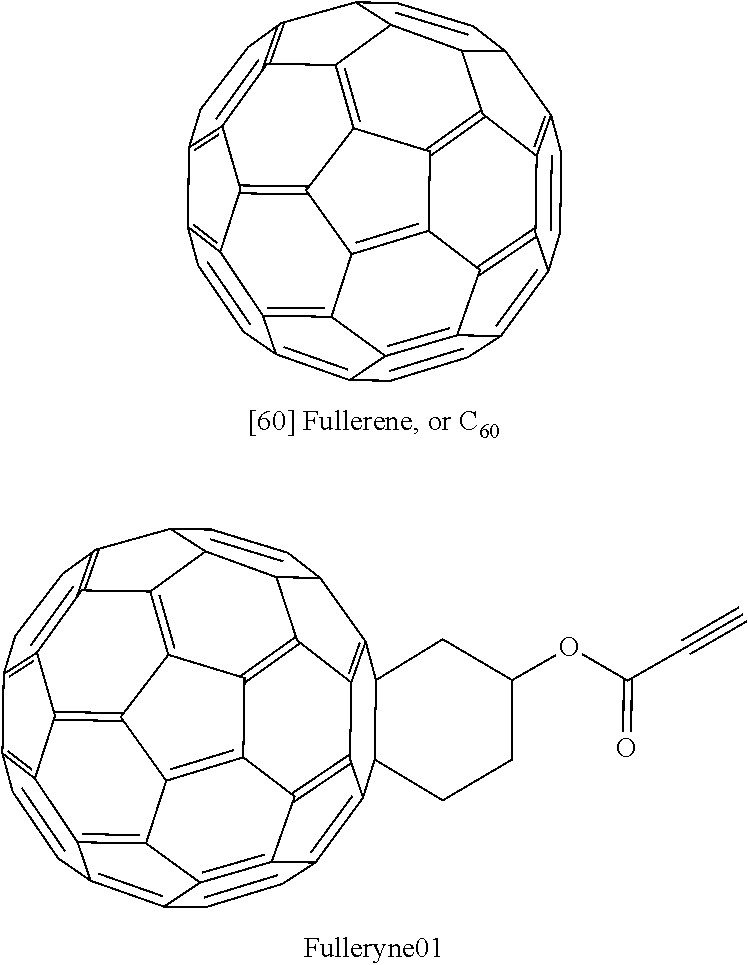Process and method for the efficient preparation of fullerynes
a technology of fullerene and process, applied in the field of preparation of novel fullerene, can solve the problems of potential polymer backbone degradation, unfunctionalized fullerene, mono- and multi-adduct mixture, and severe limits in derivatization and utilization
- Summary
- Abstract
- Description
- Claims
- Application Information
AI Technical Summary
Benefits of technology
Problems solved by technology
Method used
Image
Examples
example 1
[0075]Fulleryne01 and Fulleryne02 (Scheme 3, Fisher Esterification). Fullerene alcohol (a1 or a2, 0.3 g, ˜0.34 mmol), propiolic acid (0.565 g, 6.8 mmol), p-TsOH (29.3 mg, 0.17 mmol), 6 mL of 1-chloronaphthalene and 25 mL of toluene were added in a 100 mL round flask fitted with a Dean-Stark trap and a reflux condenser. Activated 4 Å molecular sieves were placed in the Dean-Stark trap, which was wrapped with cotton and aluminum foil to prevent heat loss. The mixture was stirred in an oil bath of 125° C. with steady reflux. After 24 h, the solution was cooled to room temperature and concentrated by rotary evaporator. The residual was directly applied to the top of the silica gel column. Hexane was first used to flush away the 1-chloronaphthalene. Toluene was then used as the eluent to afford the desired fullerynes as a black solid. Further elution with toluene / ethyl acetate mixed eluent (v / v=95 / 5) recovers the unreacted fullerene alcohol a1 or a2. For Fulleryne01, 98 mg was obtained w...
example 2
[0105]Fulleryne03 (Scheme 5). To a degassed solution of 2 (100 mg, 0.126 mmol) in 100 mL of toluene, a 1-ethynylmagnesium.chloride solution in THF (0.5 mL, 0.25 mmol) was added dropwise via syringe at 25° C. The clear dark brown solution immediately turned turbid. After 30 minutes, 1 mL of saturated aqueous ammonium chloride solution was added to quench the reaction. The solution turned clear and dark brown again with stirring. The solution was then washed with water twice and dried over anhydrous Na2S04. After removal of the solvent, the product was purified chromatographically on silica gel (toluene, Rf=0.35) to give Fulleryne03, as a brown solid (94 mg, 92%). 1H NMR (CS2:CDCl3=1:2, 500 MHz, ppm, δ): (see also figure 6.6) 4.00 (m, 1H), 3.85 (m, 1H), 3.50 (m, 3H), 3.19 (m, 1H), 2.82 (s, 1H), 2.58 (s, 1H).
[0106]13C NMR (CS2:CDCl3=2:1, 125 MHz, ppm, δ): 29.83, 34.76, 38.94, 50.22 (C—OH), 61.30 (C60, sp3-C), 63.56 (C60, sp3-C), 73.06 (C≡CH), 88.58 (C≡CH), 135.22, 141.37, 141.84, 142.3...
example 3
[0107]Fulleryne04 (Scheme 5). To a degassed solution of Fulleryne03 (158 mg, 0.194 mmol) in 100 mL of toluene cooled to 0° C. was added dropwise bis(2-methoxyethyl)aminosulfur trifluoride (88 mg, 0.40 mmol) via syringe. After 1 h, TLC showed that the reaction was complete and it was then quenched by the addition of 5% aqueous NaHCO3 solution. The solution was then washed with water twice and dried over anhydrous Na2S04. After removal of the solvent, the product was purified chromatographically on silica gel (cyclohexane:toluene=1:1 volume ratio, Rf=0.8) to give Fulleryne04, as a brown solid (120 mg, 76%). FT-IR (KBr) v (cm−1):3300 (≡C—H), 527 (C—C in C60). MS (MALDI-TOF): Calcd for C66H7F 818.05. Found: 818.05 (100%)(M+)
PUM
| Property | Measurement | Unit |
|---|---|---|
| temperature | aaaaa | aaaaa |
| temperature | aaaaa | aaaaa |
| temperature | aaaaa | aaaaa |
Abstract
Description
Claims
Application Information
 Login to View More
Login to View More - R&D
- Intellectual Property
- Life Sciences
- Materials
- Tech Scout
- Unparalleled Data Quality
- Higher Quality Content
- 60% Fewer Hallucinations
Browse by: Latest US Patents, China's latest patents, Technical Efficacy Thesaurus, Application Domain, Technology Topic, Popular Technical Reports.
© 2025 PatSnap. All rights reserved.Legal|Privacy policy|Modern Slavery Act Transparency Statement|Sitemap|About US| Contact US: help@patsnap.com



